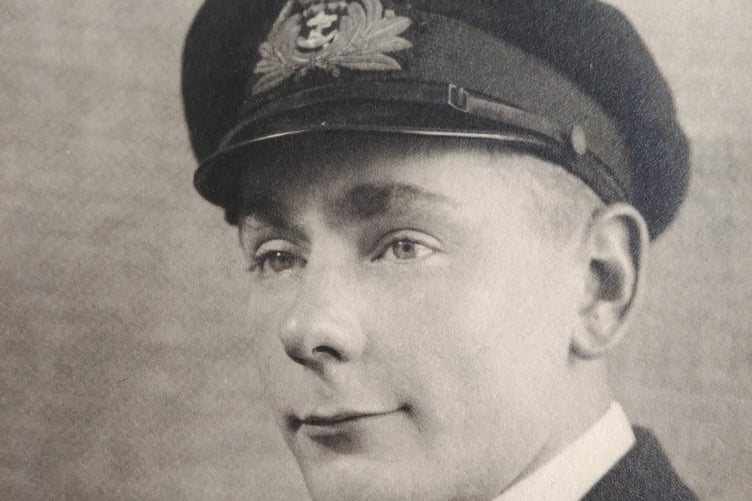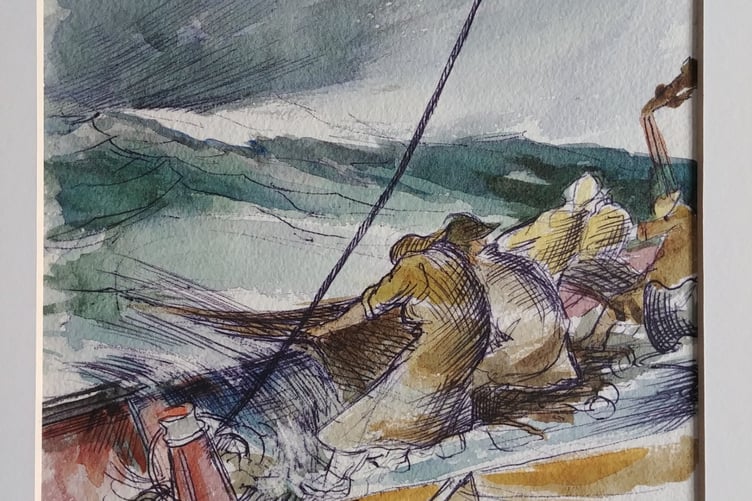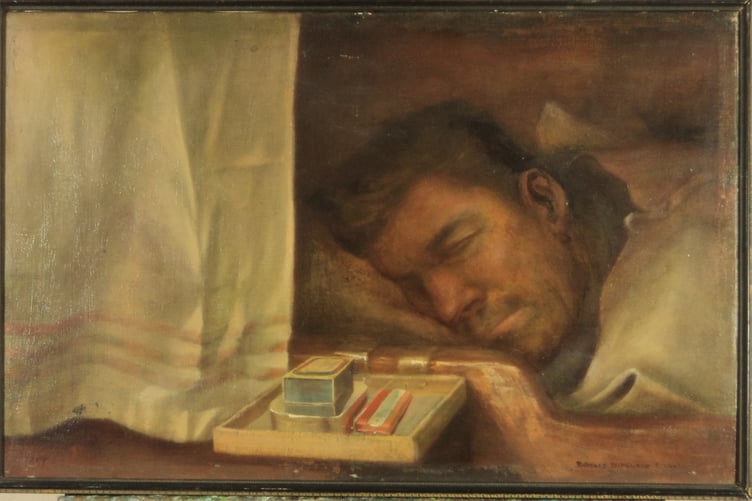The remarkable art of Donald Swan, a former deckhand on the Milford Haven steam trawler 'Maretta', will soon be on display at the Torch Theatre.
Artist Donald Sinclair Swan FRSA (1918-2004) had a huge amount of respect for the sea. From a young age, he dreamt about ships or would draw them. His passion for the depths of the ocean, and particularly the North Atlantic, feature in his collection of artworks, most of which have never been exhibited before, in the Joanna Field Gallery this May.
Father of three, Donald, was born in Glasgow, the son of a Presbyterian Minister and a former primary school teacher. He attended Glasgow High School until 1935 when, aged 16, shunning the more academic career his parents would have preferred, he joined the Clan Line shipping company, intent on a career in the Merchant Navy. This probably came as no surprise to his father, who had spent several years under sail before becoming a minister in the Church of Scotland.
A career not on the open sea wasn’t an option for Donald. The sea was in his blood, but it wasn’t all plain sailing as his daughter, Mary explains:
“In 1938, with WW2 looming, Donald transferred to the Royal Navy, serving first on HMS Barham as an RNR cadet midshipman. By September 1939 Sub Lieutenant Swan was on board HMS Wessex, heading for the Western Approaches. In 1940 he was transferred to HMT Northern Sun, a requisitioned trawler, on which he served until he contracted tuberculosis in 1941.

“The disease cut short Donald’s naval career and very nearly ended his life but, against expectation, he survived a spontaneous pneumothorax. He was, however, warned never to undertake hard physical work again.”
On the long road to recovery, Donald decided to follow his childhood dream as an artist. An avid sketcher, this had always been his second choice of career. Between 1942 and 1945, in receipt of an ex-serviceman’s grant, Donald attended Glasgow School of Art and the Patrick Allan Fraser School of Art at Hospitalfield, Arbroath with two of his most influential tutors being Hugh Crawford RSA and James Cowie RSA.
In 1945, Donald headed for London where he lived an unsettled life for several years, travelling between the capital, Glasgow and (latterly) Cornwall. A promising phase as assistant to Royal portrait painter James Gunn was interrupted by trip to the north to care for his ailing parents.
Still hankering after a life afloat and considering himself fully recovered (and in need of an income) in 1948, Donald signed on as the mate of Thames sailing barge Carina. Managing this heavy vessel under sail with just a two-man crew toughened him up, somewhat.
In 1949, once again heeding the call of the open sea, and apparently feeling the need to test himself to destruction, he left the Thames and signed on as a deckhand on the Milford Haven Steam Trawler, Maretta.
“He joined the fishing fleet at a time when the industry was recruiting from home and abroad. Fish were plentiful and large after WW2 when many trawlers had been commandeered by the Royal Navy and fish stocks were not exploited for several years,” explained Mary who found several works of art, never seen before, when she cleared her parents’ property.
“When I came across the drawings, I knew that dad would have wanted them to be exhibited in Wales. With the Milford Haven connection, I was told that the Torch Theatre was a ‘smashing place’ and hopefully the paintings might mean something to people when they visit the gallery. I really hope they’ll resonate with people,” added Mary.
Donald’s time at Milford Haven was a turning point. From “The Seaman’s Bethel, Charles St, Milford Haven, Pembrokeshire” Donald writes to an old school friend … “As you will have guessed from my address, the old curse has got me and I’m off to sea again … this time for deep sea trawling. Hard work and good money and I hope to God it lays my ghosts for keeps …”
“… From my window I can see a destroyer anchored in the Roads where we lay ten years ago and the ghosts it all brings up are quite unbelievable, and quite beyond anything I’d expected or prepared for …Still – hard work and the Atlantic air may work wonders …”

The Atlantic does seem to have laid Donald’s “ghosts.” In the 1950’s, now fully committed to art, he settled in Cornwall where he married fellow Penzance Art School student and local girl, Elizabeth Lane, the couple subsequently raising their family in a cottage near St Ives.
Milford Haven exerted a powerful influence over Donald’s art. He continued to draw throughout his time as a trawler deckhand and became adept at quickly committing to paper, the images and drama of life at sea. Later, as a marine artist he took particular pride in accurately portraying the sea in all its moods. In 1969, he mounted a solo exhibition of paintings on board the Cutty Sark at Greenwich to mark the ships’ centenary. Other maritime commissions followed, including the Mayflower, HMS Bounty and HMS Endeavour. His painting of the yacht Suhaili was chosen by its owner, round the world yachtsman, Sir Robin Knox Johnson. When Donald returned to Scotland with his family in 1972 the maritime theme continued in paintings of Clyde paddle steamers and seascapes.
Donald’s ability to draw a moving image quickly also proved invaluable when painting portraits from life – particularly children and fidgety adults. He constantly sketched people, including, as he wrote from The Bethel, while waiting to sign up for the trawler... “At the moment I’m earning my keep very nicely by drawing people …”
Donald’s own family were often practice sitters, between commissions. “Time and Family,” his family history in portraits, eventually spanning over 40 years and three generations, were exhibited several times between 1980 and 2001, in Scotland and Cornwall.
The muscularity of his trawlerman’s forearms also served Donald well when, as a potter he made a living throwing dozens of pots a day to keep the family’s shop well stocked. Both Leach trained potters, Donald and Elizabeth set up the Castle-an-Dinas Pottery in Cornwall and then the Isle of Cumbrae Pottery in Scotland to provide their bread-and-butter income.
Donald and Elizabeth returned to Cornwall in 2000, where Donald carried on painting until he was physically no longer able to do so. His last two portraits of his nephew’s children were despatched to Canada just a month before his death in November 2004. Elizabeth also continued painting into old age. She died in 2021.
This is the first time that most of these artworks have been exhibited. Donald held on to them for over 50 years and, not long before his death, brought them out, decided they were of some merit as a historical record, and mounted them.

The collection comprises some very impressionistic drawings, as well as water colours and three oil paintings, the latter completed after he left Milford Haven. Some drawings include the names of other trawlers and also of fellow crew members. The extreme hardship of this way of life is particularly well illustrated in free-flowing drawings of the crew hauling in the nets in a heavy sea; and the sheer exhaustion of men pushed to their physical limits in a minimalist drawing entitled “Up Trawl, Ballet of Sleeping Deckies”. Donald tended to record life in his sketchbooks as some might in a diary: these images are his record of, and testament to, a very hard way of life and those who lived it, for whom he held a deep and lasting respect.
The paintings by Donald Sinclair Swan FRSA will be exhibited at the Torch Theatre throughout May during Box Office opening hours. For further information visit the Torch website www.torchtheatre.co.uk, or call the Box Office on (01646) 695267.




